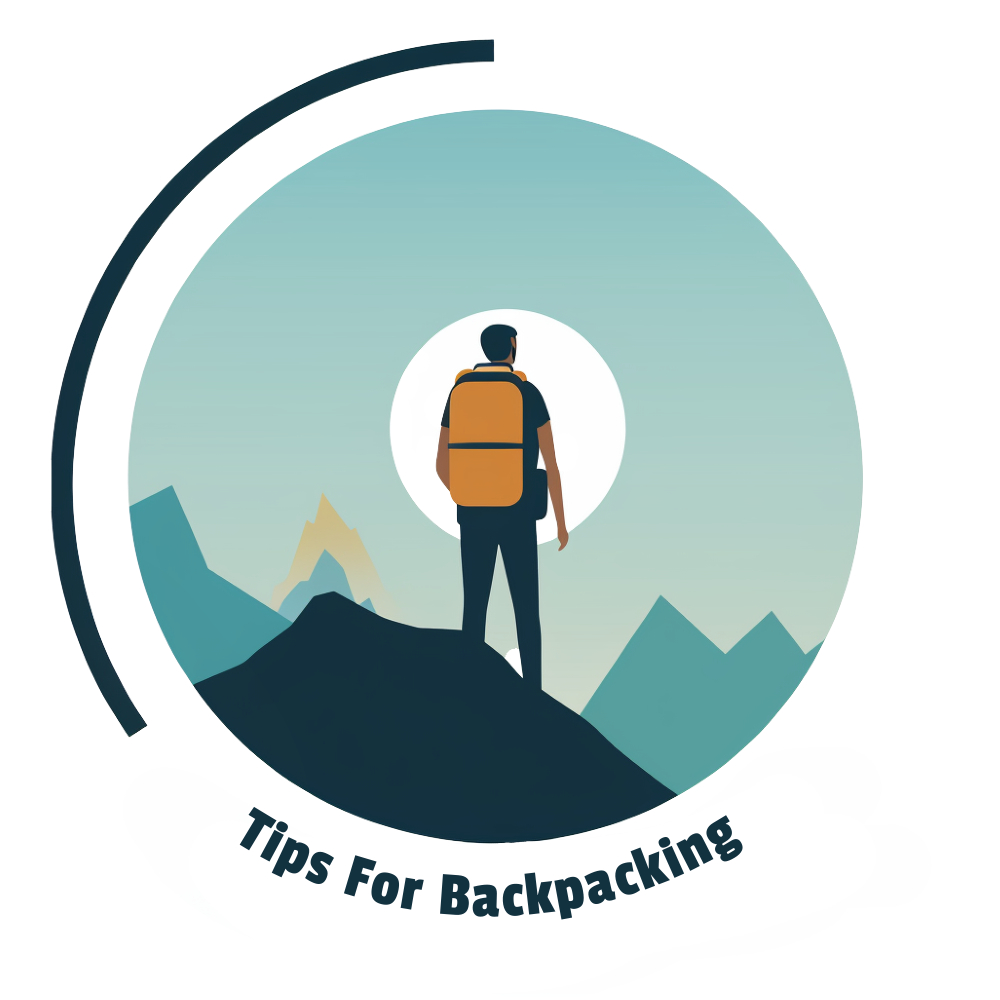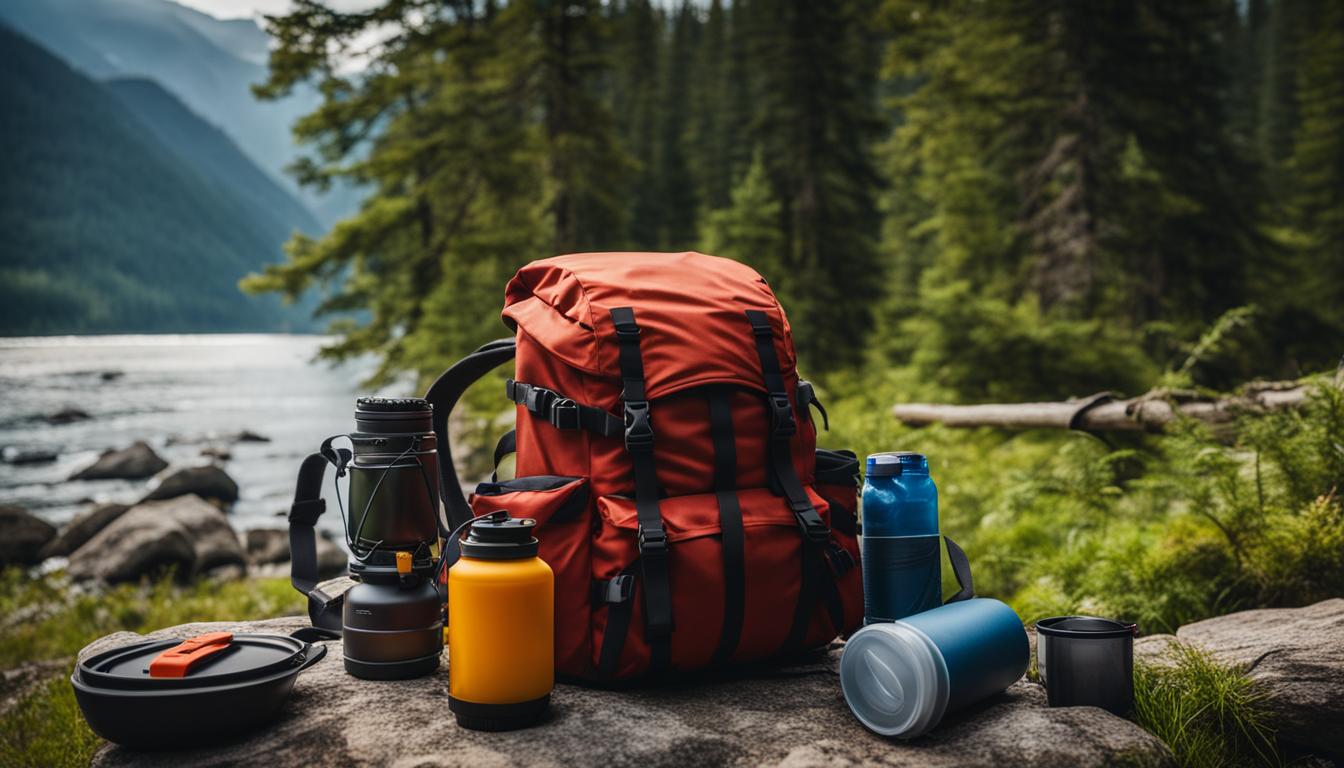When it comes to embarking on ultralight backpacking adventures, packing the right essentials is key. As someone who enjoys efficient backpacking, I understand the importance of choosing lightweight gear without compromising comfort or safety. In this ultimate guide to lightweight backpacking gear, I’ll walk you through the must-have items for your next adventure.
When it comes to backpacking essentials, optimizing your gear weight can make a world of difference. By organizing your gear into systems, you can ensure that you have everything you need while keeping your pack weight to a minimum.
In this article, we will cover the most essential gear for various systems such as hiking, navigation, shelter, sleep, cooking, hygiene/toiletries, and first aid. Each system plays a crucial role in ensuring a successful backpacking trip, and choosing the right lightweight options is key to having an enjoyable experience.
Key Takeaways:
- Ultralight backpacking requires packing the right lightweight essentials.
- Organize your gear into systems to minimize pack weight.
- Choose lightweight options for hiking, navigation, shelter, sleep, cooking, hygiene/toiletries, and first aid.
- Prioritize the essentials and only pack what is necessary for your trip.
- Enjoy a safe and comfortable backpacking journey with the right lightweight gear.
Hiking System
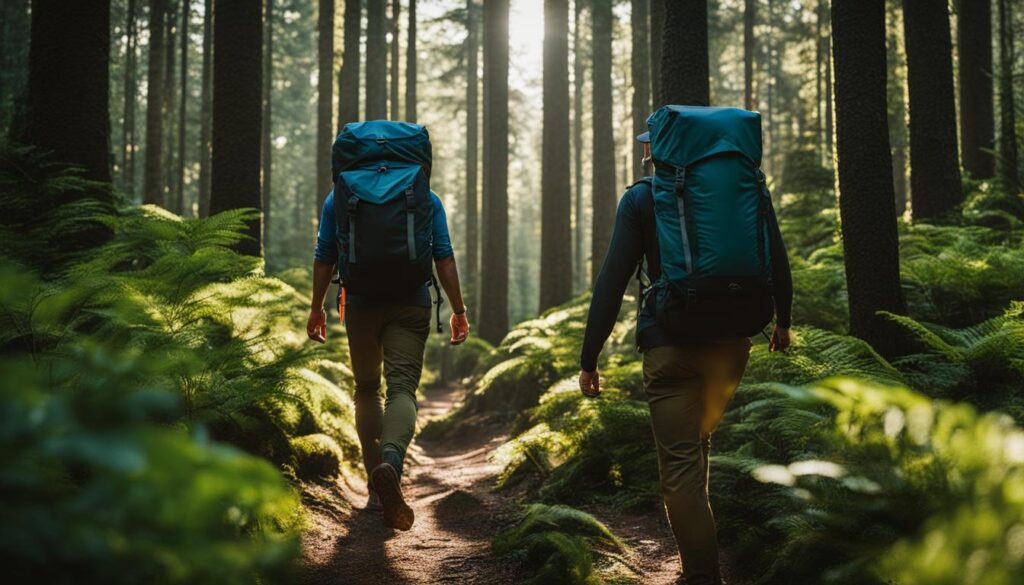
When it comes to lightweight backpacking, having the right hiking system is crucial. It ensures that you can carry your gear comfortably while minimizing strain on your body. Let’s take a look at the key components of a hiking system:
Backpack
A backpack is the cornerstone of your hiking system. Look for a lightweight backpack that offers ample storage space for your gear. Opt for one that distributes weight evenly and has a comfortable hip belt and shoulder straps for added support. Here are some top backpack options for lightweight backpacking:
| Backpack | Weight | Capacity |
|---|---|---|
| Brand A | 2.5 lbs | 40L |
| Brand B | 2.2 lbs | 50L |
| Brand C | 2.8 lbs | 35L |
Remember to choose a pack that suits your specific needs and the length of your trip.
Pack Cover
To protect your gear from rain or wet conditions, consider using a pack cover. Pack covers are lightweight and waterproof, ensuring that your belongings stay dry during unexpected downpours.
Trekking Poles
Trekking poles provide stability and help reduce strain on your joints while hiking. They also provide extra support when traversing difficult terrain or crossing streams. Look for lightweight and adjustable poles that can be easily stashed away when not in use.
Having the right hiking system is essential for a successful lightweight backpacking adventure. With a comfortable backpack, pack cover, and trekking poles, you’ll be well-equipped to tackle any trail.
Navigation System
When embarking on a backpacking adventure, having a reliable navigation system is essential. With the right tools and preparation, you can confidently navigate your route and ensure a safe journey. Here are some key components to include in your navigation system:
Map and Compass
A detailed map and a reliable compass are fundamental for navigation in the wilderness. Take the time to study your route and familiarize yourself with any key landmarks or topographical features. Use the map and compass to determine your position and orient yourself in relation to your planned route. This will help you stay on track and avoid getting lost.
Cellphone and Solar/Portable Charger
In today’s digital age, many backpackers rely on their cellphones for navigation. Ensure your cellphone is fully charged before setting out, and bring along a solar charger or portable charger to keep your device powered up. Just remember that cell service may be limited in remote areas, so it’s important to have alternative navigation tools as well.
GPS and Personal Locator Beacon
For added safety, consider bringing a GPS device or personal locator beacon (PLB). These devices can help you accurately track your position and send distress signals in emergency situations. While they can be valuable tools, it’s important to remember that they should not be relied upon as your sole means of navigation.
Route Description and Permits
Before embarking on your backpacking trip, familiarize yourself with the route description. This will provide valuable information about the trail, including any potential hazards or difficult sections. Additionally, be sure to obtain any necessary permits for your chosen route. This ensures that you are in compliance with park regulations and helps authorities keep track of hikers in the area.
| Navigation System Components | Key Features |
|---|---|
| Map and Compass | Allows for navigation and orientation |
| Cellphone and Solar/Portable Charger | Provides digital navigation capabilities |
| GPS and Personal Locator Beacon | Ensures accurate tracking and emergency communication |
| Route Description and Permits | Provides information about the trail and ensures compliance |
By including these components in your navigation system and being prepared for unforeseen circumstances, you can navigate with confidence and enjoy a successful backpacking trip.
Shelter System
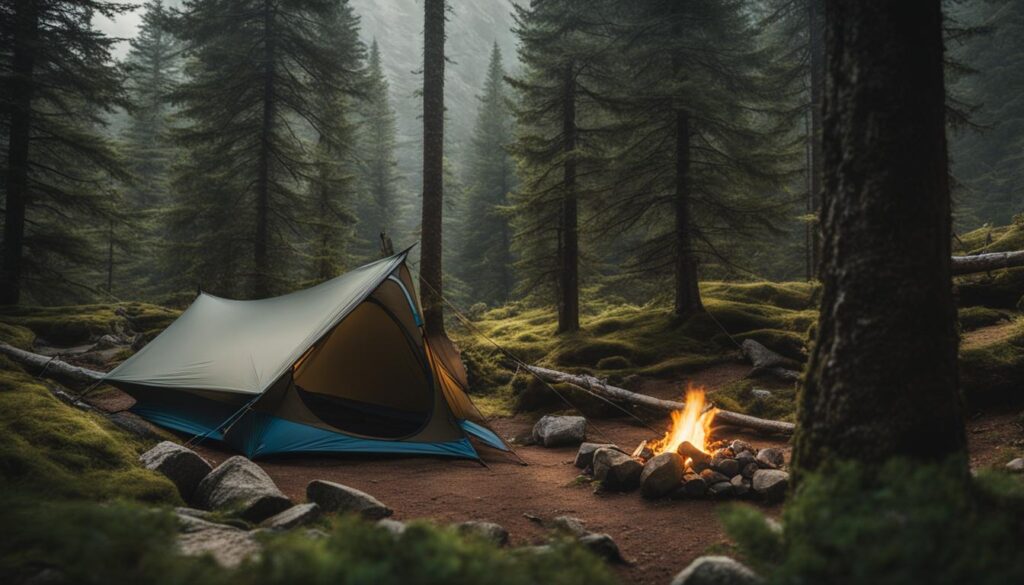
When venturing into the great outdoors, having a reliable shelter system is essential for protecting yourself from the elements. Whether you prefer a tent, tarp, bivy, or hammock, there are various options to suit your needs and preferences.
If you choose a tent, look for a lightweight and durable model that can withstand different weather conditions. Consider the number of people it can accommodate and the ease of setting it up. A tent with guylines, stakes, and insect mesh can provide added stability, security, and protection from bugs.
| Shelter Type | Pros | Cons |
|---|---|---|
| Tent | Provides privacy and protection from the elements. | Can be heavy and take up more space in your backpack. |
| Tarp | Lightweight and versatile. | May not provide as much protection from bugs or wind. |
| Bivy | Compact and easy to set up. | May feel claustrophobic for some people. |
| Hammock | Comfortable and can be set up in various locations. | Requires trees or other anchor points for setup. |
Whichever shelter system you choose, don’t forget to bring a ground cloth to provide an extra layer of insulation and protection for your sleep system. A ground cloth can also help prevent moisture from seeping into your shelter.
Remember, your choice of shelter system will depend on factors such as the weather conditions, terrain, and personal preferences. Consider the pros and cons of each option to find the shelter system that suits your needs best.
Sleep System
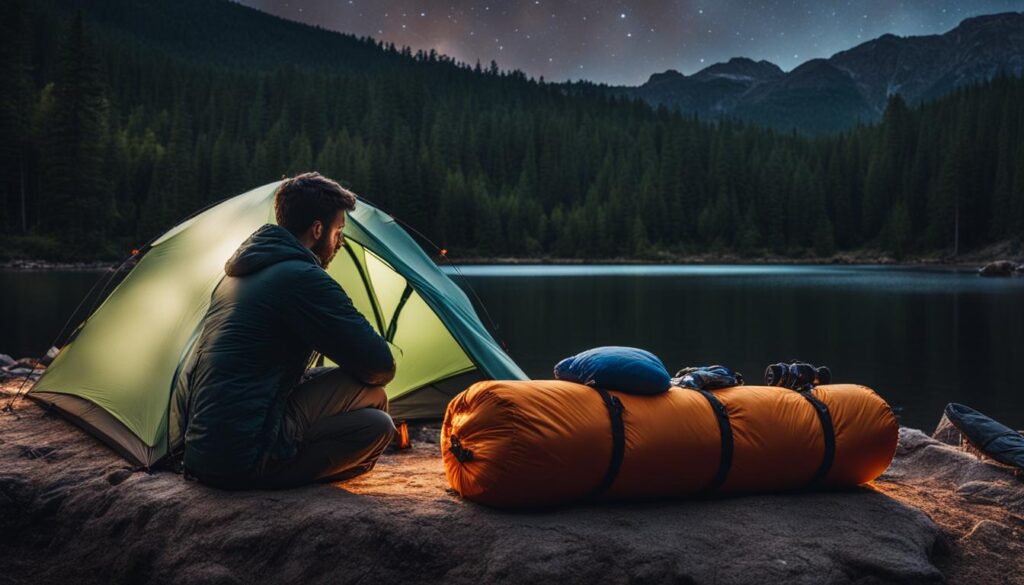
When it comes to a comfortable night’s sleep while backpacking, your sleep system plays a crucial role. Choosing the right sleeping bag, sleeping pad, and pillow can make all the difference in ensuring you get the rest you need for your outdoor adventures.
First and foremost, a high-quality sleeping bag is essential. Look for a lightweight sleeping bag that is specifically designed for backpacking. Consider the temperature rating of the sleeping bag to ensure it is suitable for the climate you will be encountering. A mummy-style sleeping bag is a popular choice among backpackers as it offers excellent warmth-to-weight ratio and helps to prevent cold air from seeping in. Remember to choose a sleeping bag that fits your body size for maximum comfort.
Next, a reliable sleeping pad is essential for insulation from the cold ground and added comfort. Look for a lightweight, compact sleeping pad that offers sufficient cushioning and insulation. Inflatable sleeping pads are popular for their light weight and excellent insulation properties. Alternatively, foam sleeping pads are a more budget-friendly option and are durable and resistant to punctures.
Finally, don’t forget to pack a small pillow for extra comfort and neck support. While it may seem like a luxury item, a pillow can greatly improve your quality of sleep during your backpacking trips. Look for a lightweight, compact pillow that can be easily packed away when not in use.
| Sleep System Essentials | Recommended Options |
|---|---|
| Sleeping Bag | – Brand X Ultralight Sleeping Bag – Temperature rating: 20°F to 30°F – Weight: 1.5 lbs |
| Sleeping Pad | – Brand Y Inflatable Sleeping Pad – R-value: 3.5 – Weight: 1 lb |
| Pillow | – Brand Z Compact Camping Pillow – Weight: 6 oz – Size: 12″ x 16″ |
Table: Recommended Sleep System Essentials
Investing in a quality sleep system is well worth it for the comfort and restful sleep it provides during your backpacking adventures. Remember to prioritize lightweight options without compromising on insulation and comfort. With the right sleep system, you’ll wake up feeling refreshed and ready to tackle the day’s hiking challenges.
Cooking System
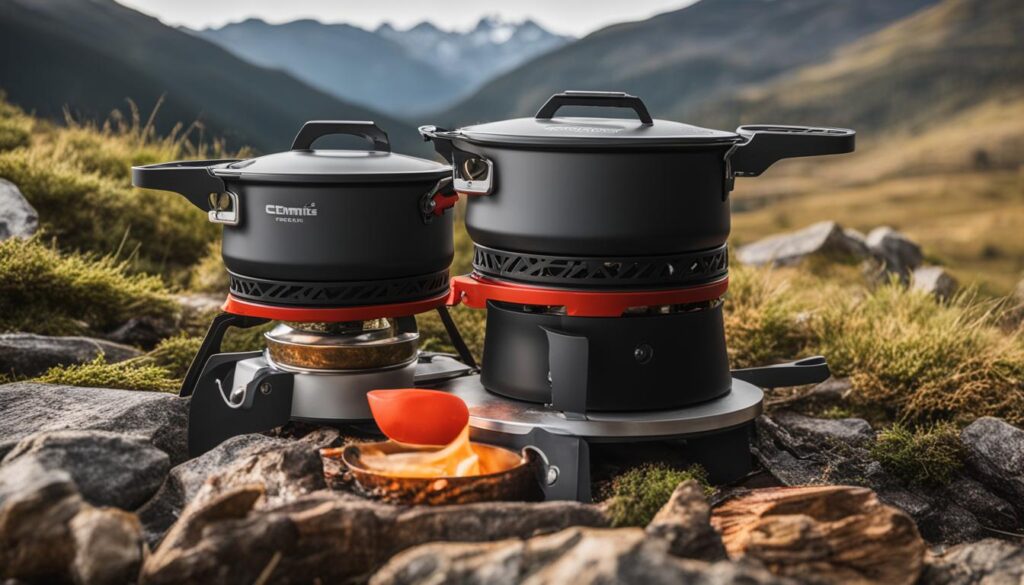
When planning for a lightweight backpacking trip, having a reliable cooking system is essential. It allows you to prepare hot meals and beverages, keeping you fueled and satisfied during your outdoor adventure. Here are the key components of a well-rounded cooking system:
Stove
Your stove selection greatly impacts the efficiency and convenience of cooking in the outdoors. Opt for a lightweight stove that is compact and easy to use. There are various options available, including canister stoves, alcohol stoves, and wood-burning stoves. Consider factors such as fuel availability, ease of use, and boil time when choosing the right stove for your needs.
Fuel
Ensure you have enough fuel to sustain your cooking needs throughout the duration of your backpacking trip. Depending on the type of stove you have, this could include canister fuel, denatured alcohol, or wood fuel. It’s crucial to estimate your fuel consumption accurately and carry a sufficient amount to avoid running out during your trip.
Lighter
A reliable ignition source is vital for lighting your stove and starting your cooking process. Carry a mini lighter or waterproof matches to ensure you can easily start your stove. It’s wise to have a backup ignition source as well, such as stormproof matches or a firestarter, in case your primary lighter fails.
Mug and Pot
A lightweight mug or pot is necessary for boiling water, cooking meals, and rehydrating food. Look for options made from durable materials such as titanium or aluminum, as they are lightweight and can withstand the rigors of outdoor use. Consider the capacity of the mug or pot based on the size of your meals and the number of people you’ll be cooking for.
Spork
A versatile utensil, the spork combines the functionality of a spoon and a fork. It eliminates the need to carry separate utensils, saving space and weight in your backpack. Choose a lightweight spork made from durable materials like titanium or plastic. Its compact size makes it easy to pack and carry.
By assembling a lightweight and efficient cooking system with a reliable stove, sufficient fuel, an ignition source, a mug or pot, and a spork, you’ll be well-prepared to cook nourishing meals during your backpacking adventure.
Hygiene/Toiletries System
When venturing into the great outdoors, proper hygiene is essential for personal well-being and maintaining a clean campsite. Here is a list of items to include in your hygiene/toiletries system for your lightweight backpacking adventure:
- Zip-top bags: Pack a few extra zip-top bags for waste disposal, storing wet items, or organizing small toiletries.
- Hand sanitizer: Keep a travel-sized bottle of hand sanitizer for hand hygiene, especially before handling food or after using shared facilities.
- Toothpaste and toothbrush: Choose a compact toothbrush and a travel-sized toothpaste tube to maintain oral hygiene.
- Biodegradable soap: Opt for a biodegradable soap that can be used for body washing and dishwashing to minimize environmental impact.
- Toilet paper: Carry a small roll of compact toilet paper or individually wrapped toilet paper sheets for bathroom needs.
- Wipes: Pack a few pre-moistened wipes for refreshing your face and body when access to water is limited.
Remember to bring any necessary menstrual products or prescription medications specific to your needs. Keeping your hygiene/toiletries system lightweight and compact will ensure that you can maintain cleanliness and freshness throughout your backpacking journey.
Pack Weight Considerations
As with every item you bring on your lightweight backpacking trip, consider the weight of each hygiene/toiletry item and whether it is absolutely necessary. For example, instead of carrying a full-sized bottle of hand sanitizer, transfer a small amount into a travel-sized container to reduce weight. Similarly, you can pre-cut small sections of toilet paper to bring only what you need, reducing bulk and weight in your pack. By carefully selecting the essential items and using travel-sized options, you can maintain proper hygiene without adding unnecessary weight to your backpack.
| Item | Weight (ounces) |
|---|---|
| Zip-top bags (3) | 0.5 |
| Hand sanitizer (2 oz) | 2.0 |
| Toothpaste (0.8 oz) | 0.8 |
| Toothbrush | 0.5 |
| Biodegradable soap (2 oz) | 2.0 |
| Toilet paper (4 rolls) | 2.0 |
| Wipes (10) | 2.5 |
| Total Weight: | 10.3 ounces |
Note: The weights provided are estimates and may vary depending on the brands and specific products you choose.
Quote:
“Maintaining proper hygiene in the wilderness is not only a matter of personal comfort but also a way to respect and preserve the natural environment. By practicing Leave No Trace principles and choosing lightweight toiletries, we can enjoy our outdoor adventures while minimizing our impact on nature.” – Jane Doe, Experienced Backpacker
First-Aid Kit
When embarking on a backpacking adventure, it’s crucial to be prepared for any medical emergencies that may arise. A well-stocked first-aid kit should be an essential item in your backpack. Here are the key components to include in your first-aid kit:
- Blister pads: These are essential for treating blisters, which are a common discomfort when hiking.
- Gauze pads: Useful for cleaning and covering wounds to prevent infection.
- Bandages: Different sizes of adhesive bandages can be used to cover cuts, scrapes, or blisters.
- Antibiotic ointment: Apply this to wounds to help prevent infection.
- Pain-relief pills: Carry over-the-counter pain relievers such as acetaminophen or ibuprofen to help alleviate pain or reduce fever.
Remember to customize your first-aid kit based on the length and difficulty of your backpacking trip. If you have any specific medical conditions or allergies, be sure to include any necessary medications or supplies.
It’s better to be safe than sorry when it comes to first-aid supplies. A well-stocked kit can make a big difference in handling minor injuries or discomforts while out on the trail.
In addition to the basic first-aid supplies, it’s a good idea to include other items in your kit:
- A headlamp or microlight with fresh batteries: This can be invaluable in low-light situations or emergencies.
- A safety whistle: Carry a whistle to attract attention in case of an emergency.
- Sunscreen: Protect your skin from harmful UV rays, even on cloudy days.
- Lip balm: Keep your lips moisturized and protected from chapping.
- Sunglasses: Protect your eyes from the sun’s glare and harmful UV rays.
- A hat with insect-mesh: This can help keep insects away from your face and ears.
By including these items in your first-aid kit, you’ll be well-prepared to handle any minor injuries or common ailments that may occur while backpacking.
Table: First-Aid Kit Essentials
| Item | Description |
|---|---|
| Blister pads | Protective pads for treating blisters |
| Gauze pads | Used for cleaning and covering wounds |
| Bandages | Adhesive bandages in various sizes |
| Antibiotic ointment | Helps prevent infection in wounds |
| Pain-relief pills | Over-the-counter pain relievers |
Miscellaneous Items
When preparing for a backpacking trip, it’s important to remember the miscellaneous items that can enhance your experience. These items may not fall into a specific system category but are still crucial for certain situations. Here are some miscellaneous items to consider:
Cash and Credit Card
While many places now accept credit cards, it’s always a good idea to carry some cash on your backpacking trip. Cash can be useful for emergencies or in situations where card payments are not possible. Make sure to carry a small amount and keep it in a secure place.
Itinerary Copies
Having copies of your itinerary can be a lifesaver in case of an emergency. Share your itinerary with a trusted friend or family member and keep a copy under the car seat. This way, if anything goes wrong, people will have an idea of where you were supposed to be and when.
Repair Kit
A repair kit can come in handy for on-trail repairs. Include gear-repair tape, a sewing needle, and nylon thread. These items can help fix small tears or other issues with your gear, ensuring that you can continue your journey without any major setbacks.
Camera, Binoculars, Journal, Pen or Pencil
Don’t forget to bring items that allow you to capture memories and observations during your backpacking journey. A camera can help you capture stunning landscapes, while binoculars allow you to observe wildlife up close. A journal and pen or pencil can be used to record thoughts, feelings, and noteworthy experiences along the way.
Remember, while these items may not be as essential as the gear in other systems, they can greatly enhance your backpacking adventure. Pack these miscellaneous items according to your personal preferences and the specific nature of your trip.
Conclusion
Packing lightweight essentials for your backpacking trip can greatly enhance your experience. By carefully choosing lightweight gear options for your hiking system, navigation system, shelter system, sleep system, cooking system, hygiene/toiletries system, and first-aid kit, you can reduce your overall pack weight while still ensuring you have everything you need for a safe and comfortable journey.
Remember to prioritize the essentials and only pack what is necessary for your trip. By minimizing unnecessary items, you can lighten your load and make your backpacking adventure more enjoyable. Whether you’re a seasoned backpacker or just starting out, adopting a lightweight approach can make a significant difference in your overall comfort and mobility on the trail.
So, get ready to hit the trails with confidence! Streamline your backpacking gear and focus on the lightweight essentials that will allow you to fully enjoy your outdoor experience. Happy backpacking!
What are the Essential Lightweight Backpacking Items that I Should Bring for Minimizing My Load?
When planning a backpacking trip, it’s crucial to pack smart to minimize your load. Some essential lightweight items for your backpacking essentials list include a lightweight tent, sleeping bag, cooking stove, water purifier, and lightweight clothing. Opting for compact, multi-purpose gear can help keep your load to a minimum.
FAQ
What are the lightweight backpacking essentials?
The lightweight backpacking essentials include a hiking system, navigation system, shelter system, sleep system, cooking system, hygiene/toiletries system, first-aid kit, and miscellaneous items. These are the must-have gear for a successful lightweight backpacking adventure.
What should I consider when choosing a backpack for lightweight backpacking?
When choosing a backpack for lightweight backpacking, consider its weight, storage capacity, and support. Look for a lightweight backpack that provides ample space for your gear and has comfortable shoulder straps and a hip belt for proper weight distribution.
How do trekking poles benefit me while backpacking?
Trekking poles provide stability and reduce strain on your joints while hiking. They can help you maintain balance and stability on uneven terrain, reduce the impact on your knees and ankles, and provide extra support when crossing streams or traversing steep slopes.
What navigation tools should I bring while backpacking?
Bring a map and compass to navigate your route. Consider bringing a cellphone with a solar or portable charger for emergency communication. Additionally, you can bring a GPS device or personal locator beacon for extra safety.
What are the options for a shelter system in lightweight backpacking?
You have several options for a shelter system in lightweight backpacking, including a tent, tarp, bivy, or hammock. Choose the option that suits your preferences and provides protection from the elements. Don’t forget to bring guylines, stakes, and additional accessories such as insect mesh or a ground cloth.
What should I look for in a lightweight sleeping bag?
When choosing a lightweight sleeping bag, consider its insulation capacity for the expected temperature range. Look for a sleeping bag made from lightweight materials with a high warmth-to-weight ratio. Ensure it is compact and easy to pack in your backpack.
How can I cook meals while backpacking?
To cook meals while backpacking, choose a lightweight stove that is compact and fuel-efficient. Bring enough fuel for the duration of your trip. You can use a mini lighter or stormproof matches for ignition. Don’t forget to pack a mug or pot for boiling water or cooking meals and a spork for eating.
How can I maintain hygiene while backpacking?
Use zip-top bags for waste disposal and storage. Carry hand sanitizer for hand hygiene. Bring a small toothbrush and toothpaste for dental care. Use biodegradable soap for body and dishwashing. Pack toilet paper and pre-moistened wipes for personal hygiene.
What should I include in a lightweight first-aid kit for backpacking?
A lightweight first-aid kit for backpacking should include blister pads, gauze pads, bandages, antibiotic ointment, pain-relief pills, any necessary prescription medications, a headlamp or microlight with fresh batteries, extra batteries, a safety whistle, sunscreen, lip balm, sunglasses, and a hat with insect-mesh.
What miscellaneous items should I bring while backpacking?
Miscellaneous items to consider bringing while backpacking include a small amount of cash and a credit card for emergencies, copies of your itinerary for friends, a repair kit with gear-repair tape, a sewing needle, and nylon thread for on-trail repairs, and optional items such as a camera, binoculars, journal, and pen or pencil to capture memories and observations during your trip.
